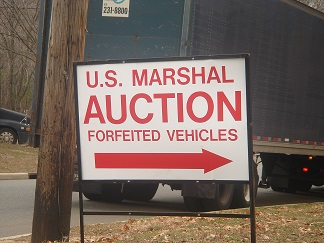 We often receive inquiries from customers about who exactly is selling all this “stuff” they see on our website. We’re going to address that question in detail in a six-part blog series about the various government agencies that dispose of sized and surplus assets. You will learn about what each agency does, where and how it gets its assets, and of course how to acquire those assets for yourself. Let’s dive right in and begin our discussion with The United States Marshals Service.
We often receive inquiries from customers about who exactly is selling all this “stuff” they see on our website. We’re going to address that question in detail in a six-part blog series about the various government agencies that dispose of sized and surplus assets. You will learn about what each agency does, where and how it gets its assets, and of course how to acquire those assets for yourself. Let’s dive right in and begin our discussion with The United States Marshals Service.
The United States Marshals Service (USMS) is on of the oldest law enforcement agencies in America. You can think of them as the police department for the Federal Government. The agency has grown considerably in size and scope since it was founded in 1789. In addition to apprehending federal fugitives, housing and transporting federal prisoners, and operating the Witness Security Program, the agency also happens to be responsible for managing and selling seized assets acquired by criminals through illegal activities.
The Marshals Service manages various types of assets, including real estate, commercial businesses, cash, financial instruments, vehicles, jewelry, art, antiques, collectibles, vessels and aircraft. It obtains these assets from various Federal agencies, including the Drug Enforcement Agency (DEA), the Federal Bureau of Investigation (FBI), the Alcohol, Tobacco and Firearms (ATF), and the Internal Revenue Service (IRS). Some of these agencies can seize and sell assets on their own, but typically they will turn them over to the United States Marhsals Service. According to the USMS, the value of the assets they had on hand as of Sept 2013 was around $2 billion. Wow that’s a lot of stuff!
Things you can get at U.S. Marshals Auctions
Cars: It’s no surprise that a large percentage of the assets the USMS handles are cars. Like a mouse to a delicious piece of cheese, criminals seem to be drawn to fancy, new cars even though it could eventually be what takes them down. The types of vehicles you will see here run the gamut from old and rundown to expensive luxury vehicles. The vehicles are sold “AS IS” so it would be wise to take that into account when placing your bids. Set your bid limit at a significant discount to what the market value really is for that vehicle. The good news is that the cars come with a “free and clear” Federal title, so you should have no problems registering with the DMV.
Boats: You definitely won’t see boats as often as you will see cars, but from time to time they do come up. We suggest bringing a mechanic with you, because many times these boats sit for a while before they are sold, and will have some mechanical problems as a result.
Planes: The USMS isn’t the best place to look for airplanes. We will suggest some good alternatives in an upcoming blog post.
Jewelry: If you’re looking for jewelry you’ve come to the right place. The USMS get’s tons of jewelry from the same place it gets its seized cars; criminals and lawbreakers. The jewelry is sold by weight, and you can often get a significant discount from the appraised value. Bringing someone who knows how to value jewelry may help somewhat, but the degree of inspection allowed is quite limited, so you will mostly be relying on the auctioneer’s description.
Miscellaneous Items: In addition to the specific items we discussed above, the USMS has a lot of general items lying around that don’t fit neatly into these categories. When someone’s property is seized, they typically lose EVERYTHING. This includes whatever they have in the house like computers, ipads, cell phones, art, rugs, and anything else you can think of.
What You Need to Know
1. You must be 18 years old to bid
2.You will be required to sign an affidavit, if you are the winning bidder, that you are not acting on behalf of the defendant. Additionally, United States Department of Justice employees and their immediate family members may be prohibited from purchasing or using assets forfeited to the United States government.
3. The winning bidder must sign a Forfeited Property Sales Certification form and make payment within 2 days of winning the auction. Acceptable payment terms vary from one auctioneer to another, but most accept cash, cashiers check, wire transfer, and some take credit cards, too.
In the weeks ahead, we’ll be exploring other government agencies such as the General Services Administration (G.S.A) and United States Customs Service.
Start looking for stuff from the United States Marshals Service by activating your free trial account right now!





